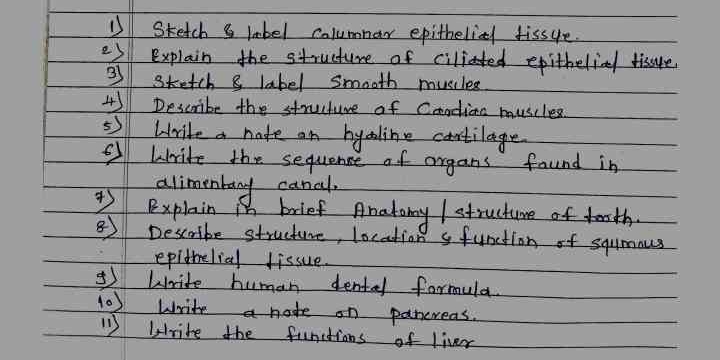1) Sketch & label columnar epithelial tissue. 2) Explain the structure of ciliated epithelial tissue. 3) Sketch & label smooth muscle. 4) Describe the structure of cardiac muscles.... 1) Sketch & label columnar epithelial tissue. 2) Explain the structure of ciliated epithelial tissue. 3) Sketch & label smooth muscle. 4) Describe the structure of cardiac muscles. 5) Write a note on hyaline cartilage. 6) Write the sequence of organs found in the alimentary canal. 7) Explain a brief anatomy/structure of teeth. 8) Describe structure, location & function of squamous epithelial tissue. 9) Write human dental formula. 10) Write a note on pancreas. 11) Write the functions of liver.

Understand the Problem
The question includes a series of tasks related to biological concepts, specifically anatomy and histology. It asks for sketches, explanations, descriptions, and anatomical details of various tissues, muscles, and organs.
Answer
1) Draw columnar cells. 2) Ciliated epithelial: cilia, move particles. 3) Smooth muscle: spindle cells, no striations. 4) Cardiac: striated, intercalated discs. 5) Hyaline: flexible, chondrocytes. 6) Alimentary canal: mouth to anus. 7) Teeth: enamel, dentin, pulp. 8) Squamous: flat cells, diffusion. 9) Dental formula: 2-1-2-3. 10) Pancreas: enzymes, insulin. 11) Liver: detox, bile, store nutrients.
- Draw tall, rectangular cells closely packed, with nuclei near the base for columnar epithelial tissue. 2) Ciliated epithelial tissue has columnar cells with cilia on their surface to move particles. 3) Smooth muscle is made of spindle-shaped cells with a single nucleus, no striations. 4) Cardiac muscles have striations, single central nucleus, intercalated discs for synchronized contraction. 5) Hyaline cartilage is a flexible tissue, bluish-white, with chondrocytes embedded in the matrix. 6) The alimentary canal sequence: mouth, pharynx, esophagus, stomach, small intestine, large intestine, anus. 7) Teeth have a crown, neck, and root - composed of enamel, dentin, and pulp. 8) Squamous epithelial tissue consists of flat, scale-like cells found in areas like the lining of blood vessels, providing a barrier and allowing diffusion. 9) The human dental formula is 2-1-2-3/2-1-2-3. 10) The pancreas has both exocrine and endocrine functions, producing digestive enzymes and hormones like insulin. 11) The liver functions in detoxification, metabolism, bile production, and storing nutrients.
Answer for screen readers
- Draw tall, rectangular cells closely packed, with nuclei near the base for columnar epithelial tissue. 2) Ciliated epithelial tissue has columnar cells with cilia on their surface to move particles. 3) Smooth muscle is made of spindle-shaped cells with a single nucleus, no striations. 4) Cardiac muscles have striations, single central nucleus, intercalated discs for synchronized contraction. 5) Hyaline cartilage is a flexible tissue, bluish-white, with chondrocytes embedded in the matrix. 6) The alimentary canal sequence: mouth, pharynx, esophagus, stomach, small intestine, large intestine, anus. 7) Teeth have a crown, neck, and root - composed of enamel, dentin, and pulp. 8) Squamous epithelial tissue consists of flat, scale-like cells found in areas like the lining of blood vessels, providing a barrier and allowing diffusion. 9) The human dental formula is 2-1-2-3/2-1-2-3. 10) The pancreas has both exocrine and endocrine functions, producing digestive enzymes and hormones like insulin. 11) The liver functions in detoxification, metabolism, bile production, and storing nutrients.
More Information
The liver is essential for metabolism and detoxification, while the pancreas plays a dual role in digestion and glucose regulation. Teeth structure and the arrangement offer insights into dietary habits and health.
Tips
When labeling tissues, remember to identify cell shapes and arrangements. For organ sequences, memorize common anatomical pathways.
AI-generated content may contain errors. Please verify critical information